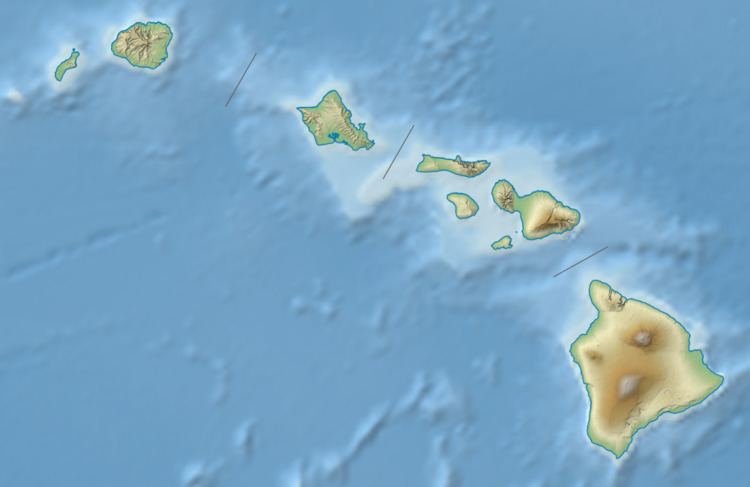Area 122.5 acres (49.6 ha) Reference no. 09000855 Year built 1943 | Governing body National Park Service Address Waipahu, HI 96797, USA Date closed 1945 | |
 | ||
Website Honouliuli National Monument Designated 000000002015-02-19-0000February 19, 2015 Designated 000000002012-02-21-0000February 21, 2012 Similar Japanese Cultural Center of, Pullman National Monument, Sand Island, Col Charles Young H, Browns Canyon National | ||
Honouliuli internment camps
The Honouliuli Internment Camp, Hawaiʻi's largest and longest-operating internment camp, opened in 1943 and closed in 1946. Located near Waipahu on the island of Oʻahu, the site was designated Honouliuli National Monument by Presidential Proclamation on February 19, 2015 by President Barack Obama. The internment camp held 320 internees and also became the largest prisoner of war camp in Hawai‘i with nearly 4,000 individuals being held. Of the seventeen sites that were associated with the history of internment in Hawaiʻi during World War II, the camp was the only one built specifically for prolonged detention. As of 2015, the new national monument is without formal services and programs.
Contents
- Honouliuli internment camps
- Honouliuli internment camp fire station
- Construction and operation
- Closure and aftermath
- Notable internees
- References
Honouliuli internment camp fire station
Construction and operation
Run by the U.S. Army, the camp's supervisor was Captain Siegfried Spillner. The camp was constructed on 160 acres (0.65 km2) of land near Ewa and Waipahu on the island of Oahu to hold internees transferred from the soon-to-close Sand Island camp. It opened in March 1943. An 8-foot (2.4 m) dual barbed-wire fence enclosed the camp, and a company of military police stood guard from its eight watchtowers. Of the seventeen sites that were associated with the history of internment in Hawaiʻi during World War II, the camp was the only one built specifically for prolonged detention. The isolated location in a deep gulch led Japanese American internees to nickname it jigoku dani (地獄谷, "hell valley").
The camp was designed to hold 3,000 people. At one time it held 320 U.S. civilians. It was divided by barbed wire into sections, intended to separate internees by gender, nationality, and military or civilian status. By August 1943, there were 160 Japanese Americans and 69 Japanese interned there, according to the report of a colonel from the Swedish Legation who inspected the camp under the Geneva Convention.
Eventually, the camp held more than 4,000 Okinawans, Italians, German Americans, Koreans, and Taiwanese as well. The first Korean prisoners were believed to have arrived in late 1943 or early 1944; they comprised non-combatant laborers captured during the Gilbert and Marshall Islands campaign. A Korean-language newsletter, the Free Press for Liberated Korea (자유한인보), was written and mimeographed by three Korean soldiers of the Japanese Imperial Army interned in the camp; it continued publication until December 1945. Beginning in 1943, the Japanese American internees were either released on parole or transferred to Department of Justice camps on the mainland. After the third transfer in November 1944, twenty-one U.S. civilians remained in Honouliuli and the camp served primarily as a holding center for POWs. At the end of the war, some 4,000 POWs were confined at Honouliuli; repatriation efforts began in December 1945 and continued into 1946.
Closure and aftermath
After the camp's closure, the land was leased by the Oahu Sugar Company from the Campbell Estate and sugar cane was grown on adjacent lands. In 2007, the Monsanto Corporation purchased the land.
The fact that Honouliuli Gulch had once held an internment camp was largely forgotten until the late 1990s. Jane Kurahara, a volunteer from the Japanese Cultural Center, located it in 2002 by tracing an aqueduct in the background of an old photo. The efforts to learn more about the camp's history attracted the attention of the NPS (National Park Service). A followup NPS survey concluded that the camp was eligible for listing on the National Register of Historic Places. The site and the U.S. Immigration Station in Honolulu played a central role as internment sites in Hawai‘i during World War II. The site met the criteria for national significance and was added to the register on February 21, 2012.
On July 6, 2012, the state created an advisory group to develop and present recommendations for an educational resource center to lawmakers in the next legislative session. The Japanese Cultural Center of Hawai‘i conducts public tours of the former camp. Two buildings and some other remnants still remain at the site, which current-owner Monsanto is interested in transferring to the National Park Service. The site was designated "Honouliuli National Monument" by Presidential Proclamation on February 19, 2015, by President Barack Obama. The site was formally dedicated as a U.S. National Monument on March 31, 2015, in a ceremony at the Japanese Cultural Center of Hawaiʻi. In attendance were the United States Secretary of the Interior, the Governor of Hawaiʻi, the Mayor of Honolulu, and representatives of the legislature of the State of Hawaiʻi. As of 2015, the new national monument is without formal services and programs but the Japanese Cultural Center of Hawaiʻi has been providing information to the public. The University of Hawai‘i at West Oʻahu and the Japanese Cultural Center of Hawaiʻi are two institutions that potentially will have increased access to the site under the auspices of the National Park Service.
